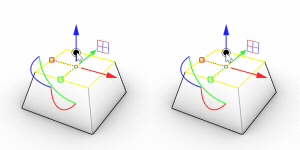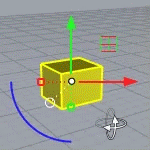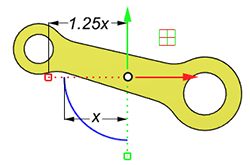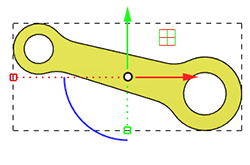Gumball
| Toolbar | Menu | Status bar |
|---|---|---|
|
|
|
The Gumball command displays the gumball widget on a selected object facilitating move, scale, and rotate transformations around the gumball origin.
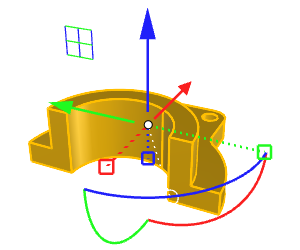
Steps
- Click the Gumball pane in the status bar to toggle visibility the Gumball transform widget.
Command-line options
On / Off / Toggle
Turns the Gumball widget on or off for the selected object, or toggles between on and off.
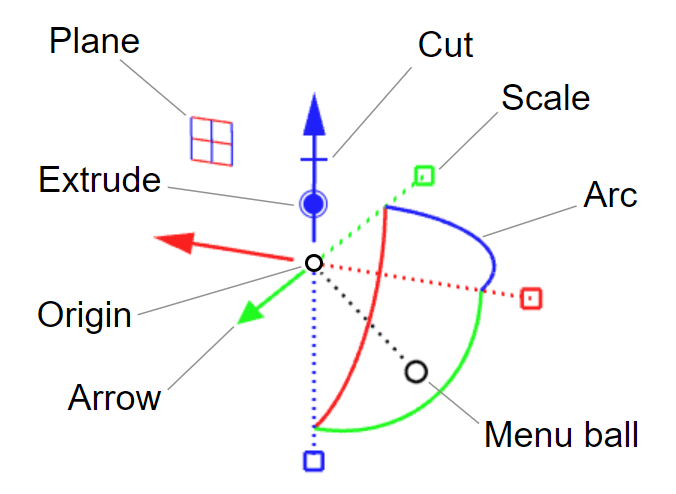
To show tooltip for handle actions
-
Point the mouse cursor to a handle to show the tooltip for actions and modifier keys.
-
The actions and modifier keys can vary based on the selected object type.
-
The tooltips can be turned on or off from the Cursor ToolTips options.
-
To hide handles
- Run the GumballSettings command.
- Select the Handles option.
- Turn off the handles you would like to hide on the Gumball widget.
Move 2D (Plane) handle actions
Move planar
-
Drag a Move 2D handle to constrain movement on the plane.
-
Direction lock and Distance constraint can be enabled.
-
Extrude - Ctrl (⌘ on Mac)
-
Drag with Ctrl (⌘) to constrain extruding direction on the plane.
Copy - Tap Alt (⌥ on Mac)
-
While dragging, tap Alt (⌥) to make a copy of the object.
-
Tap Alt (⌥) again to leave copy mode.
-
Scale2D - Shift (⇧ on Mac)
-
Drag with Shift (⇧) to re-size the object in two axes with the same scale.
-
The Gumball origin is the base point of scaling.
-
-
Shift (⇧) + click on the Move 2D handle to type a scale factor.
Move gumball planar - Double click
-
Double-click on a Move 2D handle to relocate Gumball on the plane.
-
Move the mouse and click, or type a distance and press Enter.
Extrude handle actions
Extrude
-
Drag an Extrude handle to extrude the object along the arrow axis.
-
A closed planar curve or a surface can be extruded as a solid.
-
An inner edge loop of a surface can be extruded as a separate solid.

-
A planar closed loop consisting of separate curves can be extruded as a solid.

-
Distance constraint can be enabled.
-
Extrude does not allow creating Non-manifold SubD or mesh objects.
-
SubD-friendly curves will be extruded into SubD objects.
-
Open extrude - Ctrl (⌘ on Mac)
-
Drag with Ctrl (⌘) to force extruding a closed planar curve or a surface as an open object.
Both sides - Shift (⇧ on Mac)
-
Drag with Shift (⇧) to extrude towards both sides.
- The Both sides mode is only available in some circumstances. For example, when a surface or a curve is selected.
Extend Face - Shift (⇧ on Mac)
-
Drag with Shift (⇧) to extend or shorten the faces surrounding the selected face.
- The Extend mode is only available when all the surrounding faces are planar.
- When the Extend mode is possible for the selected face, the Extrude handle shows a circle around the dot.
|
|
|
|
Extend
|
Extrude
|
The PushPull command provides the similar editing abilities of the Extrude / Extend handle.
Copy - Tap Alt (⌥ on Mac)
-
While dragging, tap Alt (⌥) to create a separate object.
- Tap Alt (⌥) again to leave copy mode.
-
Alt (⌥) + click on an Extrude handle to create a separate object with numeric input.
Numeric entry - Click
-
Click on the Extrude handle to type the extruding distance.
Origin point actions
-
Drag the Gumball origin point to move the whole object in any direction.
-
Direction lock and Distance constraint can be enabled.
-
Control point style and size settings in display modes control the appearance of the Gumball origin point.
-
Move handle actions
Move
-
Drag the x, y, or z arrow to move the objects in the arrow direction.
-
Distance constraint can be enabled.
-
Extrude - Ctrl (⌘ on Mac)
-
Drag with Ctrl (⌘) to make closed extrude.
-
This key combination acts like the Extrude handle.
-
Copy - Tap Alt (⌥ on Mac)
-
While dragging, tap Alt (⌥) to create a copy of the object.
-
Tap Alt (⌥) again to leave copy mode.
-
-
Alt (⌥) + click on a move handle to copy with numeric input.
Numeric entry - Click
-
Click on the move handle to type the moving distance.
-
While typing the distance, pressing Shift (⇧)+
 /Enter/Space/Tab moves the object in the opposite direction.
/Enter/Space/Tab moves the object in the opposite direction.
-
Move Gumball
- Double-click on an arrow to relocate Gumball along the direction.
- Move the mouse and click, or type a distance and press Enter.
Menu ball (Bunny tail) actions
Click
-
Click on the circle to show the Gumball menu.
-
The same menu can be accessed from the Gumball pane on the status bar.
-
The alternative way of showing the Gumball menu:
Right-click and hold on any part of the Gumball widget. When the page icon
 appears, release the right mouse button.
appears, release the right mouse button.
The Right mouse button settings in Options > Mouse control the display timing of the page icon and the accessibility of the Gumball menu.
and the accessibility of the Gumball menu. -
Change the size in Gumball options. Set 0 to turn it off.
-
Gumball menu
Relocate Gumball
Drag to relocate gumball widget away from its default position.
Reset Gumball
Restores the default placement and orientation for the gumball.
AutoReset Gumball
When an object is rotated, resets Gumball to align with CPlane or World axes based on the initial alignment.
Gumball On
Turns the gumball widget on any time objects are selected.
Gumball Off
Disables auto gumball.
Align to CPlane
Gumball widgets align to the construction plane xyz directions. The Gumball origin will be at the CPlane oriented bounding box center of the object.
Align to Object
Gumball widgets align to the object.
The default alignment is different for different object types.
Align to World
Gumball widgets align to world xyz directions. The Gumball origin will be at the World oriented bounding box center of the object.
Snappy Dragging
Object snaps are used when dragging.
Smooth Dragging
Object snaps are ignored when dragging.
Merge faces after extrude
Merges the coplanar faces related to the extruding operation when possible.
Rotate View Around Gumball
When the Gumball widget is visible, rotate the view around the Gumball origin. Otherwise, rotate the view around the center.
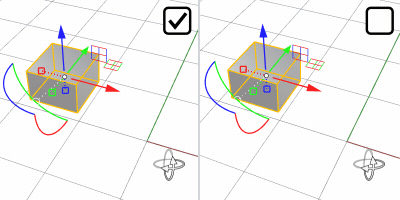
Drag Strength
Sets the amount of the gumball drag as a percentage of mouse movement to control the speed of the gumball movement. The default 100% moves the gumball consistently with the mouse.
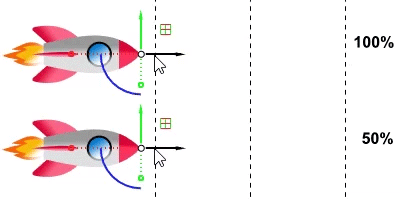
To fine-tune placing objects (such as with control point editing) set the strength lower, so large hand/mouse movements result in smaller gumball changes. When the control is closed, drag strength is reset to 100%.
Settings...
Opens Gumball options.
Rotate handle actions
Rotate
- Drag the x, y, or z arc to rotate the object around the axis.
-
Angle constraint and Ortho can be enabled.
Extrude - Ctrl (⌘ on Mac)
-
Drag with Ctrl (⌘) to make a straight loft between the start and end angles.
Copy - Tap Alt (⌥ on Mac)
-
While dragging, tap Alt (⌥) to create a rotated copy of the object.
- Tap Alt (⌥) again to leave copy mode.
-
Alt (⌥) + click on a rotate handle to copy with numeric input.
Numeric entry - Click
-
Click on a rotate handle to type the rotation angle.
Rotate gumball - Double click
-
Double-click on an arc to turn the Gumball widget around the axis.
-
Move the mouse and click, or type an angle and press Enter.
Scale handle actions
Scale1D
-
Drag a scale handle to scale in one dimension along the arrow.
-
The Gumball origin is the base point of scaling.
-
Distance constraint can be enabled.
-
When Object Snap is on, dragging a scale handle near the Gumball origin will snap to it. The object will be made flat in the scaling direction.
-
Extrude - Ctrl (⌘ on Mac)
-
Drag with Ctrl (⌘) to extrude inwards or outwards.
Scale3D - Shift (⇧ on Mac)
-
Drag with Shift (⇧) to scale the object in three dimensions.
Copy - Tap Alt (⌥ on Mac)
-
While dragging, tap Alt (⌥) to create a scaled copy of the object.
-
Tap Alt (⌥) again to leave copy mode.
-
-
Alt (⌥) + click on a scale handle to copy with numeric input.
Numeric entry - Click
-
Click on a scale handle to type a scale factor.
Move handles - Double click
-
Double-clink on a scale handle to change its length.
-
Move the mouse and click, or type a scale factor and press Enter.
Cut handle actions
Cut
-
Drag a cut handle to extrude a closed planar curve to cut the intersected object, similar to the BooleanDifference command.
-
If the cutting curve is an open curve that can cut across the intersected object, both sides of the object will be kept, similar to the BooleanSplit command.
-
The cut handle only appears on the axis vertical to the curve plane. (Left)

-
Boss - Ctrl (⌘ on Mac)
-
Drag with Ctrl (⌘) to add the extrusion to the intersected object, similar to the BooleanUnion command.
Both sides - Shift (⇧ on Mac)
- Drag with Shift (⇧) to extrude the curve towards both directions.
Numeric entry - Click
-
Click on a cut handle to type an extrusion distance.
Common operations
Some operations work the same way on different Gumball handles.
Numeric input
-
Click on any handle.
-
Type a number for distance, rotation angle, or scale factor.
Copy object
-
Drag any handle.
-
While dragging, tap Alt (⌥) to toggle copy mode on.
Tap Alt (⌥) again to toggle copy mode off.
Copy object with numeric input
-
Alt (⌥) + click on any handle.
-
Type a number for distance, rotation angle, or scale factor.
Use distance and angle constraint
Normal Rhino distance and angle constraints can be used during a gumball operation.
-
While dragging a handle, type a number, and press Enter.
-
Continue dragging the handle.
Distances are constrained along the axis arrow line.
Angles are constrained in increments of the angle around the rotation handle.
Change Gumball widget location and orientation
To move, rotate, or scale Gumball widget freely
- Double-click on a handle.

- Drag the handle and release.
To move rotate, or scale Gumball widget with numeric input
-
Ctrl (⌘) + Double-click on a handle.

- Type a number in the value box for distance, rotation angle, or scale factor.
Related commands
|
Toolbar |
Menu |
|---|---|
|
|
The GumballSettings command changes Gumball appearances from Command-line options.
Command-line options
AutoGumball
Turns on the Gumball widget for the selected object.
SnappyGumball
Uses object snaps when dragging one of the Gumball handles.
Colors
Sets the colors of the Gumball handles in X, Y, and Z directions.
Handles
Changes the visibility of Gumball components.
MoveHandle
The arrows including the cutting line and extrude dot.
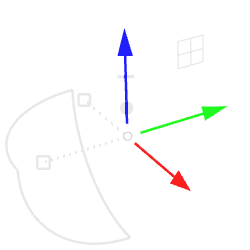
RotateHandle
The arcs around the X, Y, and Z axes.
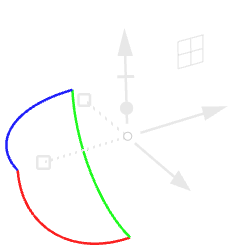
ScaleHandle
The small rectangles and the dotted lines connecting to the Gumball origin.

PlaneHandle
The window icons on the XY, YZ, and XZ planes.

ExtrudeHandle
The dot on the Z arrow shaft.
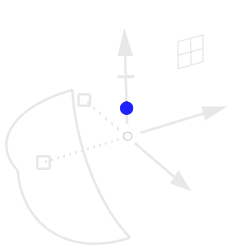
CutHandle
The short line on the Z arrow shaft.

MenuHandle
The small circle and the dotted line connecting to the Gumball origin.

Sizes
Sets the size of the Gumball widget and handles in pixels.
- Set 0 for a handle to turn it off.
Radius
The size of the arcs and arrows.
TipLength
The length of the arrow heads.
TipWidth
The width of the arrow heads.
TailSize
The size of the small rectangles.
PlaneLocation
The distance between a window icon and the Gumball origin.
PlaneSize
The size of the window icons.
PlaneVisibilityAngle
The angle of view for a window icon to be visible. Details...
AxisThickness
The thickness of the arrow shafts.
ArcThickness
The thickness of the arcs.
MenuBallDistance
The distance between the Gumball origin and the menu circle.
MenuBallSize
The radius of the menu circle.
ExtrudeBallSize
The size of the extrude dots.
It also controls the size of the cut handle.
RotateViewAroundAutoGumball
When the Gumball widget is visible, rotate the view around the Gumball origin. Otherwise, rotate the view around the center.

MergeFacesAfterExtrude
Merges the coplanar faces related to the extruding operation when possible.
| Toolbar | Menu | Status bar | Gumball widget menu |
|---|---|---|---|
|
|
|
<Options> |
Align to CPlane Align to Object Align to World Align to View |
The GumballAlignment command resets the gumball widget alignment.
Note
- Alignment will not change if you have previously modified the gumball position or orientation.
- Right-click the gumball and use Reset from the gumball context menu to force the new alignment for these objects.
- Alignment is based on the object bounding box.
| Command-line options | |
|---|---|
|
CPlane |
Sets the gumball widget alignment to the active construction plane. |
|
Object |
Sets the gumball widget alignment to the selected object. The object aligned gumball is placed at the planar face center unless the object is a picture frame. |
|
World |
Sets the gumball widget alignment to world coordinates. |
| View |
Sets the gumball widget alignment to the view plane of the current viewport.
|
|
Toolbar |
Menu |
|---|---|
|
|
The GumballDynamicRelocate command allows relocating Gumball by dragging one of its controls.
Steps
-
Drag one of the Gumball controls. Press Enter when done.
Snapping Dragging is always enabled when relocating Gumball.
The GumballDynamicRelocate command can be run by double-clicking on a gumball control.
See Also
GumballRelocate
Changes the Gumball widget location and orientation of on an object.
| Toolbar | Menu |
|---|---|
|
|
|
The GumballScaleMode command sets the size of the scale handles either relative to the gumball radius or based on the object size. This command does not affect the move handles (arrows) and rotate handles (arcs).
| Command-line options | |
|---|---|
|
Mode |
RelativeThe length of scale handles is the product of Gumball radius (in pixels) multiplied by the value of RelativeHandlePositionMultiplier. Since the length is based on pixels, zooming the view does not change the handle length on the screen. Gumball Radius=x with RelativeHandlePositionMultiplier=1.25
AbsoluteThe length of scale handles is based on model units. The handles extend to the object's bounding box boundary and scale with the object. Numerical inputsClick on a scale handle and enter a number to scale the object in one direction.
For the absolute mode only, the number supports units.
To toggle the mode with a macro
|
|
RelativeHandlePositionMultiplier |
Only used by the Relative mode. It specifies the size of the scale handles relative to the Gumball radius setting. Numbers larger than 1 make the gumball scale handles longer than the Gumball radius. Numbers between 0 and 1 make the gumball scale handles shorter than the Gumball radius. |
| Toolbar | Menu | Gumball widget menu |
|---|---|---|
|
|
|
Relocate Gumball |
The GumballRelocate command moves the gumball origin and orientation of an object.
The other way to move Gumball is to press and hold Ctrl (⌘) and drag the Gumball widget rather than the object.
Steps
-
Pick a location for the Gumball origin.
Continue with step 2, or press Enter to align Gumball to World, CPlane, or View axes based on the current Gumball alignment mode. When Gumball aligns to object, the current orientation is used.
-
Pick a point to set the x-axis direction.
-
Pick another point to set the y-axis direction.
The z-axis direction is set according to the Right-hand rule.
Command-line options
SetScaleHandles
Sets the length of the x, y, and z scale handles.
| Toolbar | Menu | Gumball widget menu |
|---|---|---|
|
|
|
Reset Gumball |
The GumballReset command makes the orientation of the gumball instantly snap back to its original location after being relocated with GumballRelocate.
|
Toolbar |
Menu |
Status bar |
|---|---|---|
|
|
|
AutoReset Gumball |
The GumballAutoReset command makes the orientation of the gumball snap back to its starting location after every transformation.
This setting allows free rotation of the object while constraining the original orientation.
Command-line options
On / Off / Toggle
Turn on, off, or toggle auto reset of Gumball orientation.

